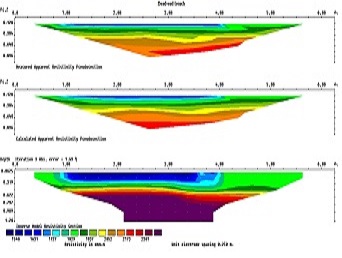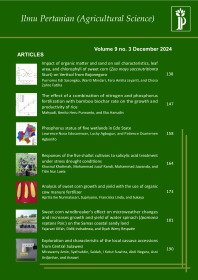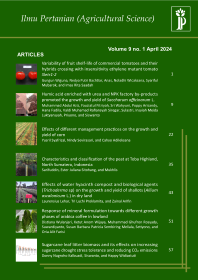
Morphological characters of root and yield of three cocoa (Theobroma cacao L.) clones in the field with dead-end trench
Canggih Nailil Maghfiroh(1), Eka Tarwaca Susila Putra(2*)
(1) Department of Agronomy, Faculty of Agriculture, Universitas Gadjah Mada Jln. Flora, Bulaksumur, Sleman, Yogyakarta 55281
(2) Department of Agronomy, Faculty of Agriculture, Universitas Gadjah Mada Jln. Flora, Bulaksumur, Sleman, Yogyakarta 55281
(*) Corresponding Author
Abstract
Cocoa (Theobroma cacao L.) is a perennial crop originated from tropical regions, divided into Criollo, Forastero, and Trinitario. Demand for cocoa has increased, but the productivity is still low. The increase in production could be achieved by improving crop management and using superior clones. RCC-70, RCC-71, and KKM-22 are recommended as the superior cocoa clones. Dead-end trench can reduce erosion and surface run-off as well as improve rooting and soil organic matter sequestration. The objectives of this research were to study the effects of dead-end trench application on morphological characters of roots and yields of three cocoa clones and to determine which cocoa clone(s) performed a signifificant yield increase with the application of dead-end trench. The research was conducted in August 2018–April 2019 at Pagilaran Ltd. cocoa plantation in North Segayung Production Unit, subdistrict Tulis, Batang, Central Java. The experiment was arranged in a randomized complete block design with two factors and three replications as block. The first factor was dead-end trench application (with and without dead-end trench application) and the second factor was cocoa clones (RCC-70, RCC-71, and KKM-22). This study showed that application of dead-end trench and clones significantly increased root fresh weight, root dry weight, seed fresh weight, and seed dry weight, but had no significant effect on fruit diameter, fruit length, root length, and root surface area. RCC-70 clone, coupled with the application of dead-end trench, resulted in the highest seed dry weight compared to RCC-71 and KKM-22 clones.
Keywords
Full Text:
PDFReferences
Amos, T.T. and O.A. Thomson. 2015. Climate change and the cocoa production in the tropical rain forest ecological zone of Ondo State, Nigeria. Journal of Environment and Earth Science, 5: 36-41.
Bianco, M.D. and S. Kepinski. 2018. Building a future with root architecture. Journal of Experimental Botany, 69: 5319-5323.
Borden, K.A., L.C.N. Anglaaere., S. Adu-Bredu., and M.E. Isaac. 2017. Root biomass variation of cocoa and implications for carbon stocks in agroforestry systems. Springer Agroforestry System, 93: 369-381.
Carr, M.K.V., and G. Lockwoods. 2011. The water relations and iirgation requirements of cocoa (Theobroma cacao L.) : a review. Experimental Agriculture, 47: 653-676.
Cojocairu, A., E.Chelariu., C. Tanase. 2018. Adventitious roots development and root system architecture of chrysanthemum cuttings. Journal of Plant Development, 25: 92-98.
Dias-Jose., O. Dias-Jose., S. Mora-Flores., R. Rendon-Medel., and R. Telles-Delgado. 2014. Cacao in Mexico : Restrictive factors and productivity levels. Chilean Journal of Agricultural Research, 74: 397-403.
Ipinmoroti, R.R., and J. S. Ogeh. 2014. Soil nutrient synamic under old and youn cocoa, coffee, and cashew plantation at Uhonmora, Edo State, Nigeria. Journal Tropical Soil, 19 : 85-90.
Kamga, K. M. D., D. T. Tchatchoua., R.G., G.Y.A. Bessa., & L.J. Baleba. 2018. Rooting ability of cocoa (Theobroma cacao L.) stem cuttings : effect of genotype, cutting type, hormone concentration, and their interactions. Asian Journal of Agricultural and Horticultural Research, 1: 1-10.
Kurniawan, E. Ardian, and Wawan. 2014. Sifat kimia tanah dan perkembangan akar kelapa sawit (Elaeis guineensis Jacq.) pada berbagai dimensi rorak dengan pemberian tandan kosong. Jom Faperta, 1: 1-12.
Ministry of Agriculture. 2017. Statistik perkebunan Indonesia Kakao 2015-2017. https://drive.google.com/file/d/1sG27lYoxAtwrnFmlobgyAJdoVHv3YEb6/view
Murtilaksono, K., W. Darmosarkoro., E.S. Sutarta. H.H Siregar., and Y. Hidayat. 2009. Upaya peningkatan produksi kelapa sawit melalui penerapan teknik konservasi tanah dan air. Jurnal Tanah Tropika, 1: 135-142.
Nazari, Fakhrurrazie., N. Aidawati., and Gunawan. 2015. Deteksi perakaran kelapa sawit pada lubang biopori modifikasi dengan metode geolistrik resistivitas. Ziraa’ah, 40: 31-39.
Nugroho, P.A. 2017. The study of silt pits establishment and empty fruit bunch application in rubber plantation. Inovasi, 14: 155-161.
Pratiwi and A.G. Salim. 2013. Aplikasi teknik konservasi tanah dengan sistem rorak pada tanaman Gmelina (Gmelina arborea Roxb.) di KHDTK Carita, Banten. Jurnal Penelitian dan Konservasi Alam, 10: 273-282.
Putra, D. R., B. Utomo., and A. Dalimunte. 2016. Morfologi perakaran tumbuhan monokotil DNA tumbuhan dikotil. Jurnal Universitas Sumatera Utara., 5: 1-10.
Rajoniati. 2006. Pertumbuhan tunas sambung samping beberapa klon pada berbagai ketinggian batang utama tanaman kakao. Makassar: Sistem Pertanian Program Pascasarjana, Universitas Hasanuddin Makassar.
Satibi, M., Nasamsir., and Hayata. 2019. Pembuatan rorak pada perkebunan kopi Arabika (Coffea arabica) untuk meningkatkan produktivitas. Jurnal Media Pertanian, 4: 74-80.
Setiyono, R.T. 2012. Bahan tanaman unggul mendukung bioindustri kakao. Balai Penelitian Tanaman Industri dan Penyegar, 1: 3-11.
Simpen, I.N., N.P.G.B.Dewi., and I.N.Aribudiman. 2018. Relationship betweem resistivity and soil strength based on geoelectric data. International Journal of Life Sciences, 2: 22-29.
Smith, M.R., I.M. Rao., and A. Merchant. 2018. Source-sink relationships in crop plants and their influence on yield development and nutritional quality. Frontiers in Plant Science, 9: 1-6.
Suryana, A.T., A Fariyanti., and A, Rifin. 2014. Analisis perdagangan kakao Indonesia di pasar internasional. Jurnal Tanaman Industri dan Penyegar, 1: 29-40.
Wang, X., J. Yun., P. Shi., Z. Li., P. Li., and Y. Xing. 2018. Root growth, fruit yield, and water use efficiency of greenhouse grown tomato under different irrigation regimes and nitrogen levels. Journal of Plant Growth Regulation, 38: 400–4.
Wijaya, A.S. 2015. Aplikasi metode Geolistrik Resistivitas konfigurasi Wenner untuk menentukan struktur tanah di Halaman belakang SCC ITS Surabaya. Jurnal Fisika Indonesia, 55: 1-5.
Wood, G. A. R. 1985. Cocoa. 4th ed : New York: Longman Inc.
Yuliasmara, F. 2016. Strategi mitigasi perkebunan kopi menghadapi perubahan iklim. Warta Pusat Penelitian Kopi dan Kakao, 28: 1-7.
Article Metrics
Refbacks
- There are currently no refbacks.
Ilmu Pertanian (Agricultural Science) ISSN 0126-4214 (print), ISSN 2527-7162 (online) is published by Faculty of Agriculture Universitas Gadjah Mada collaboration with Perhimpunan Sarjana Pertanian Indonesia (PISPI) and licensed under a Creative Commons Attribution-ShareAlike 4.0 International License.













